¶ Meetings
Meetings is an application that allows users to manage and connect geographically dispersed teams, increase productivity, and ensure high quality performance. Its implementation in PBXware brings an easier form of communication enabling users to organize and conduct meetings while at the same time taking into consideration their location, time zone, or personal schedules.
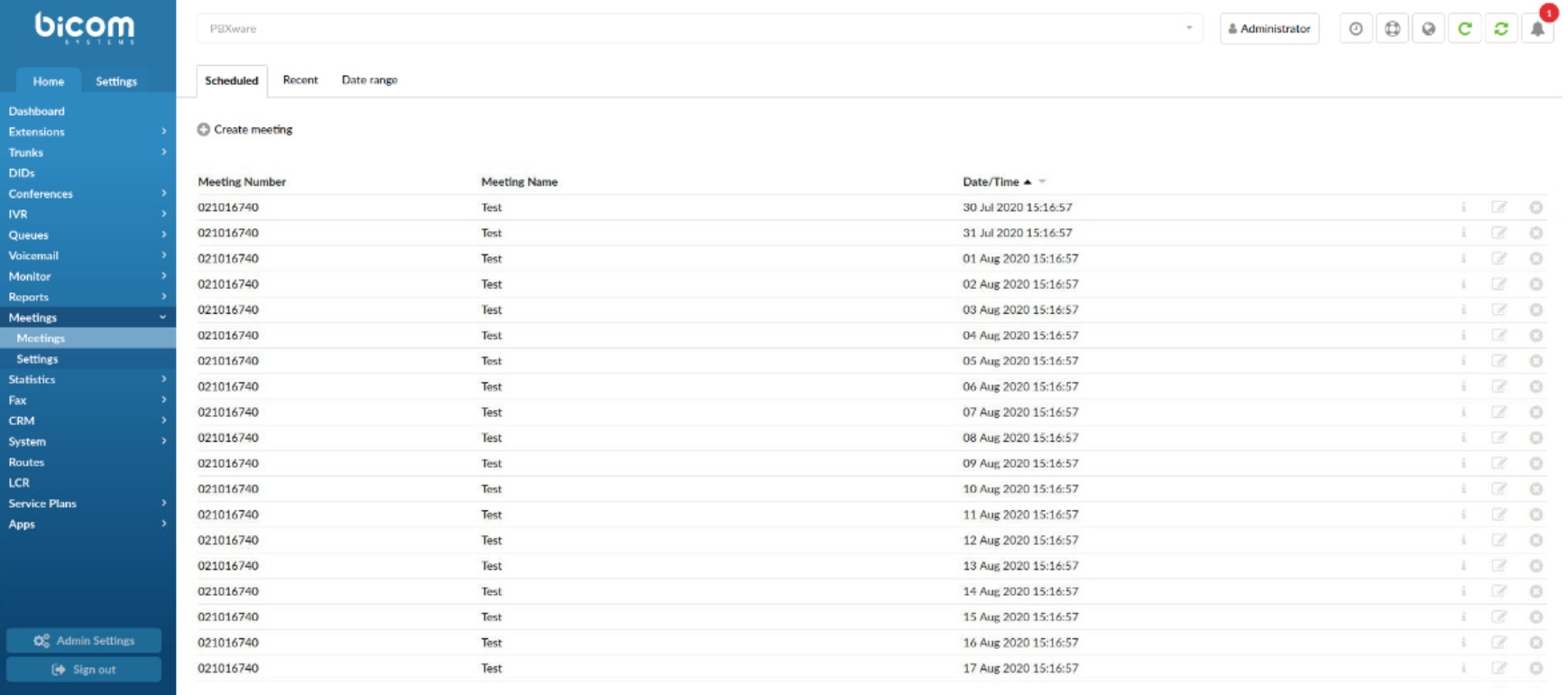
¶ Create a Meeting
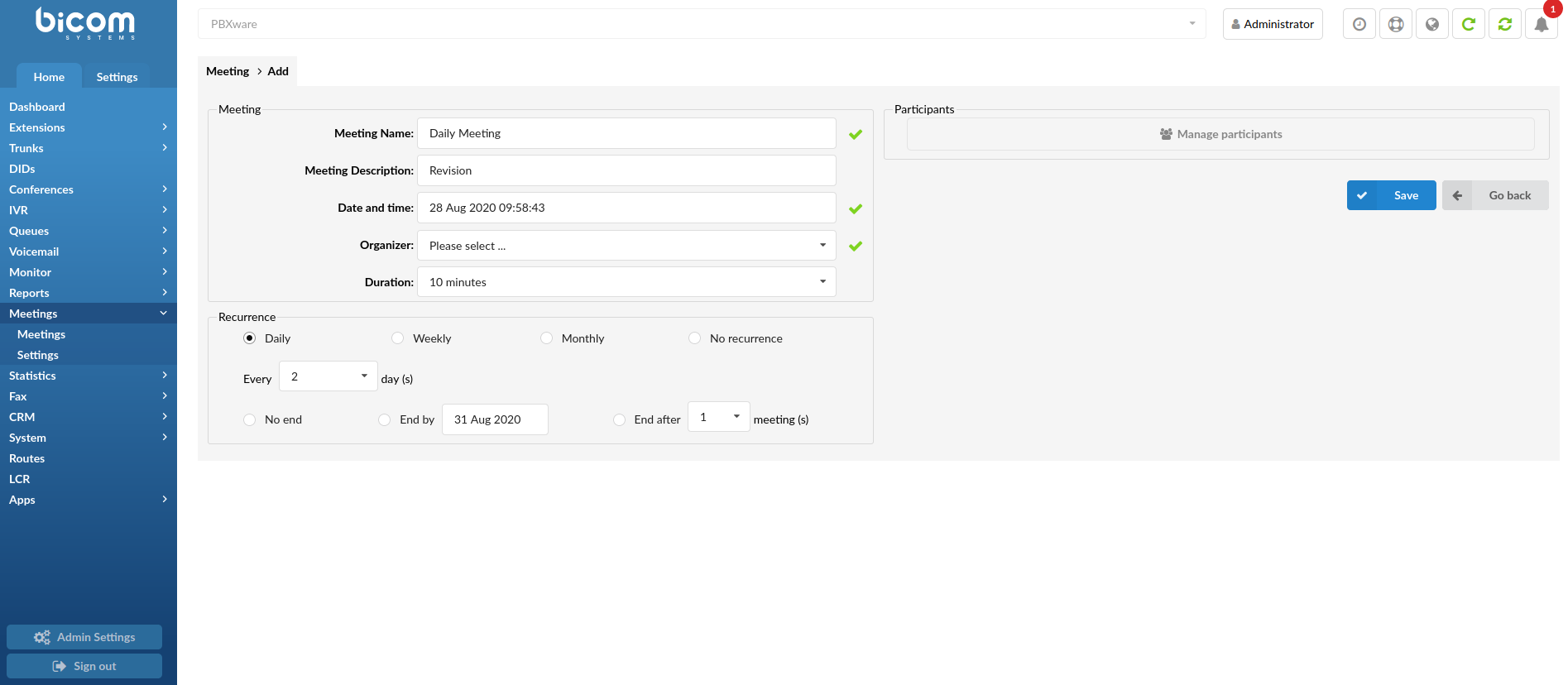

Click this button to create a meeting.
(Button)
NOTE: 'Meeting Name', 'Date and time', and 'Organizer' are three required fields. Not defining those fields will result in the warning messages being shown. Please refer to the screenshots.
¶ Meeting
- Meeting Name

Enter a meeting name.
(E.g. Daily Meeting)
[(a-z)(0-9)]
- Meeting Description
Populate the field with more information regarding the meeting.
(E.g. Revision)
[(a-z)(0-9)]
- Date and time

Choose the meeting's date and time.
NOTE: Date and time cannot be set in the past. Please refer to the screenshot.
(E.g. 06 Sep 2020 12:01:00)
(Option button)
- Organizer

Select the organizer of the meeting from the list of Extensions.
(E.g. Ext 100 (100))
(Select box)
- Duration
Set the meeting's duration. It ranges from minimum of 10 minutes up to the maximum of 2 hours.
(E.g. 15 minutes)
(Select box)
¶ Recurrence
Recurrence options are used to create meetings that are repeated at specific time intervals:

(Check box)
¶ Daily

If 'Daily Recurrence' is selected, meetings can be repeated every 1 to 90 days.
(E.g. If '1' is selected, the meeting will be repeated every day, or if '4' is selected, the meeting will be repeated every four days, and so on.)
(Select box)
Users can select the recurrence's End Type as follows:
- No end: A meeting is held every day with no further time limitations.
(E.g. Time limitation will not affect the meeting's recurrence.)
(Option button)
- End by: A meeting will stop recurring on a specific date.
(E.g. Once 31st of August is reached, the meeting will stop recurring, so in September there will be no meetings.)
(Option button)
- End after: A meeting will stop recurring after a specified number of meetings.
(E.g. If '8' is selected, the meeting will stop recurring after eight conducted meetings.)
(Option button)
NOTE: Only one type of recurrence can be selected at a time.
| DAILY | ||
|---|---|---|
| Repetition | (in) Days | |
| Repetition Period | (from) 1 - 90 (days) | |
| Recurrence End Type | No End/End By/End After |
¶ Weekly

If 'Weekly Recurrence' is selected, meetings can be repeated every 1 to 12 weeks.
(E.g. If '1' is selected together with days from Monday to Friday, the meeting will be repeated every week on the specified days.)
(Select box)
Users can also identify specific days in a week with the range being from Monday to Sunday.
(E.g. Mon, Tue, Wed, Thu, Fri)
(Check box)
Users can select the recurrence's End Type as follows:
- No end: A meeting is held every week with no further time limitations.
(E.g. Time limitation will not affect the meeting's recurrence.)
(Option button)
- End by: A meeting will stop recurring on a specific date.
(E.g. Once 31st of August is reached, the meeting will stop recurring, so in September there will be no meetings.)
(Option button)
- End after: A meeting will stop recurring after a specified number of meetings.
(E.g. If '38' is selected, the meeting will stop recurring after thirty-eight conducted meetings.)
(Option button)
NOTE: Only one type of recurrence can be selected at a time.
| WEEKLY | ||
|---|---|---|
| Repetition | (in) Weeks | |
| Repetition Period | (from) 1 - 12 (weeks) | |
| Week Days | (on) Mon - Sun | |
| Recurrence End Type | No End/End By/End After |
¶ Monthly

If 'Monthly Recurrence' is selected, there are two ways that recurrence can be configured.
1.
Meetings can be repeated every 1 to 6 months with the specific date selected ranging from the 1st to the 31st.
(E.g. If '20' is selected for the 'Date' together with '1' for months, the meeting will be repeated every month on the 20th.)
(Select boxes)
2.
Meetings can be repeated from every 1st to 4th and from Mon to Fri within the range of 6 months.
(E.g. If '2' is selected for the date, 'Mon' for days and '1' for months, the meeting will be repeated every second Monday in a month.)
(Select boxes)
Users can select the recurrence's End Type as follows:
- No end: A meeting is held every month with no further time limitations.
(E.g. Time limitation will not affect the meeting's recurrence.)
(Option button)
- End by: A meeting will stop recurring on a specific date.
(E.g. Once 31st of August is reached, the meeting will stop recurring, so in September there will be no meetings.)
(Option button)
- End after: A meeting will stop recurring after a specified number of meetings.
(E.g. If '20' is selected, the meeting will stop recurring after twenty conducted meetings.)
(Option button)
NOTE: Only one type of recurrence can be selected at a time.
| MONTHLY | ||
|---|---|---|
| Repetition | (in) Months | |
| Repetition Period | (every) 1st - 31st (in) 1 - 6 (Months) | |
| Days/Months | (every) 1st - 4th Mon - Sun (in) 1 - 6 (Months) | |
| Recurrence End Type | No End/End By/End After |
¶ No Recurrence
If 'No Recurrence' is selected, meetings are not repeated.
(Check box)
| NO RECURRENCE | ||
|---|---|---|
| Repetition | None | |
| Repetition Period | None | |
| Recurrence End Type | None |
¶ Participants

When creating a meeting, users can add numerous participants. If the meeting is created for the first time, the 'Manage participants' field will be grayed out as shown in the screenshot. To make the field clickable, it is needed for all required fields to be populated as well as additional information regarding 'Recurrence'.
Once done, press the 'Save' button, and the 'Manage participants' button becomes clickable as shown in the screenshot.

¶ Add Participants
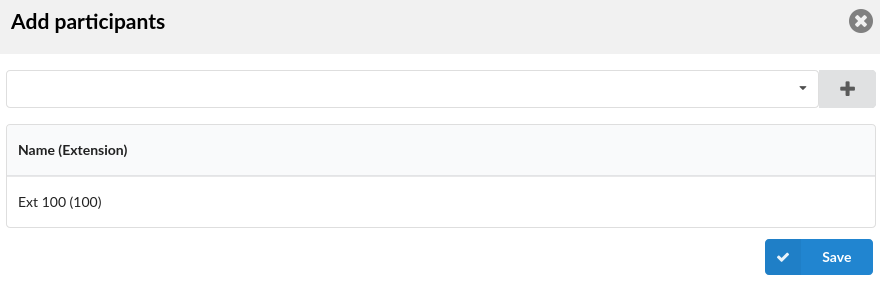
Upon clicking the 'Manage participants' button, users will be prompted to the 'Add Participants' page. From here, they can see, add, or delete the Extensions.
NOTE: Please note that the organizer's Extension only will be visible at first.
(E.g. Ext 100)
(Display)

Once the organizer chooses desired Extensions from the drop-down list found at the top of a page, s(he) needs to press the plus sign as shown in the screenshot. The list will display all Extensions for that specified meeting.
(E.g. Ext 100, Ext 721, Ext 103)
(Button)
If everything is done successfully, the message saying “Participants edited successfully” is displayed as shown in the screenshot.

![]() Click this button to delete a participant from the Participants' list.
Click this button to delete a participant from the Participants' list.
NOTE: It is not possible to delete the organizer of the meeting.
(Button)
When using the Meetings application, it is possible to see three tabs: 'Scheduled', 'Recent', and 'Data Range'. They all display different information on meetings that are planned to be held or have been held.
¶ Scheduled

The list displays all scheduled meetings with the following details:

Click this button to create a meeting.
(Button)
NOTE: For more information on creating meetings, please refer to the link.
- Meeting Number:
Unique on the system with 9 digits.
NOTE: Hovering the mouse over the 9 digit meeting number and clicking it will prompt users to the Meeting Details page.
(E.g. 301027545)
(Display)
- Meeting Name:
Name given by the organizer when creating a Meeting.
NOTE: Hovering the mouse over the meeting name and clicking it will prompt users to the Meeting Details page.
(E.g. Daily Meeting)
(Display)
- Date/Time:
Meeting's date and time.
NOTE: It displays the date and time of current and planned meetings.
(28 Jul 2020 09:49:27)
(Display)
 Click this button to see the 'Meeting Details' page.
Click this button to see the 'Meeting Details' page.
NOTE: For more information on the page's content, please refer to the Meeting Details page.
(Button)
 Click this button to update the meeting.
Click this button to update the meeting.

NOTE: Upon clicking the button, the following warning message will appear: "Do you want to update all or just this instance of recurring meeting?". If 'Update this instance' is clicked, then any changes made to the meeting will be applied only to this recurring meeting. Otherwise, if users click the 'Update all instances' button, then changes will be applied to all meetings on the list.
For more information, please refer to the screenshot.
(Button)
 Click this button to delete the meeting.
Click this button to delete the meeting.

NOTE: Upon deleting a single meeting, the warning message will appear saying "Are you sure you want to delete this meeting?". However, if a user deletes a recurrent meeting, the following warning message will appear: "Do you want to delete all or just this instance of recurring meeting?". If 'Delete this instance' is clicked, then only this recurring meeting will be deleted. Otherwise, if users click the 'Delete all instances' button, then all meetings on the list will be removed.
For more information, please refer to the screenshots.

(Button)
¶ Recent
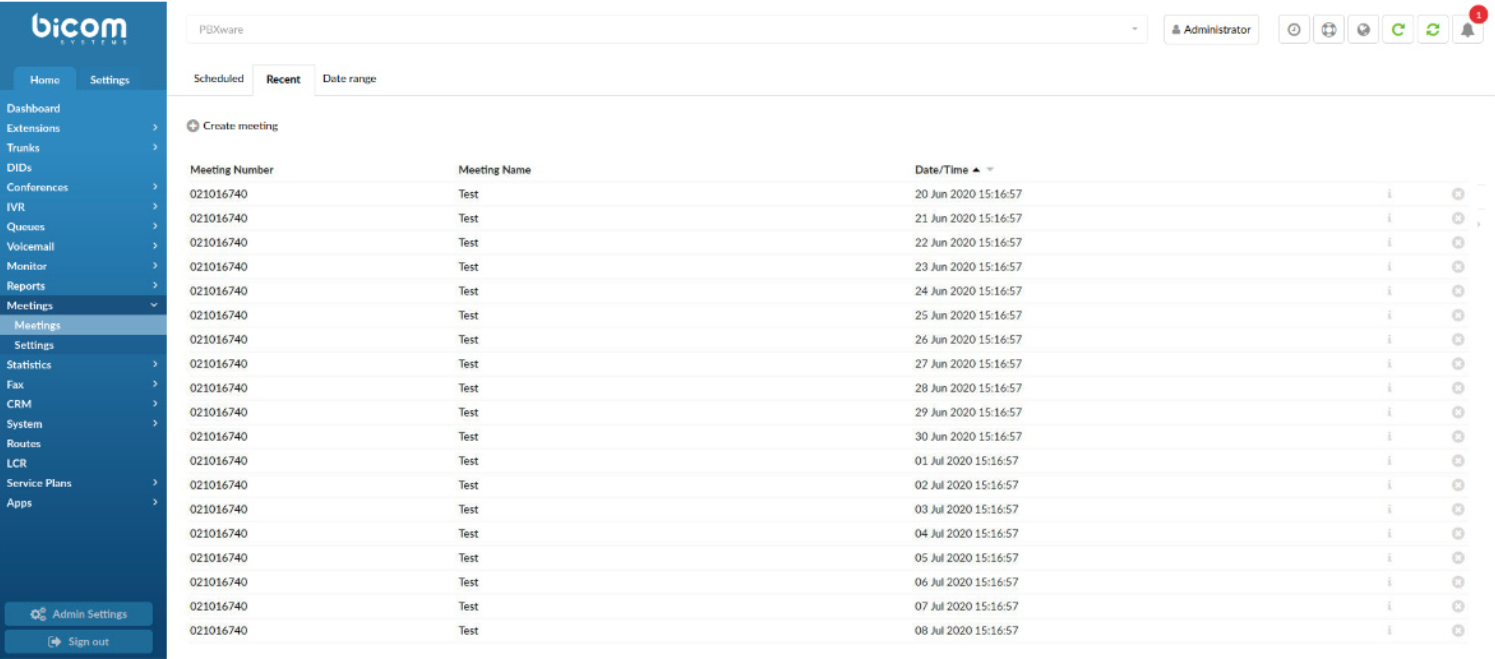
The list displays all recent finished meetings with the following details:

Click this button to create a meeting.
(Button)
NOTE: For more information on creating meetings, please refer to the link.
- Meeting Number:
Unique on the system with 9 digits.
NOTE: Hovering the mouse over the 9 digit meeting number and clicking it will prompt users to the Meeting Details page.
(E.g. 301027545)
(Display)
- Meeting Name:
Name of a previous Meeting.
NOTE: Hovering the mouse over the meeting name and clicking it will prompt users to the Meeting Details page.
(E.g. Daily Meeting)
(Display)
- Date/Time:
Meeting's date and time.
NOTE: It displays the date and time of previous meetings.
(28 Jul 2020 09:49:27)
(Display)
 Click this button to see the 'Meeting Details' page.
Click this button to see the 'Meeting Details' page.
NOTE: For more information on the page's content, please refer to the Meeting Details page.
(Button)
 Click this button to delete the meeting.
Click this button to delete the meeting.

NOTE: Upon deleting a single meeting, the warning message will appear saying "Are you sure you want to delete this meeting?". However, if a user deletes a recurrent meeting, the following warning message will appear: "Do you want to delete all or just this instance of recurring meeting?". If 'Delete this instance' is clicked, then only this recurring meeting will be deleted. Otherwise, if users click the 'Delete all instances' button, then all meetings on the list will be removed.
For more information, please refer to the screenshots.

NOTE: If users delete a recurrent meeting on the 'Recent' page by pressing Delete all instances, all instances of the meeting will be deleted including the ones found on the 'Scheduled' page.
(Button)
¶ Date Range
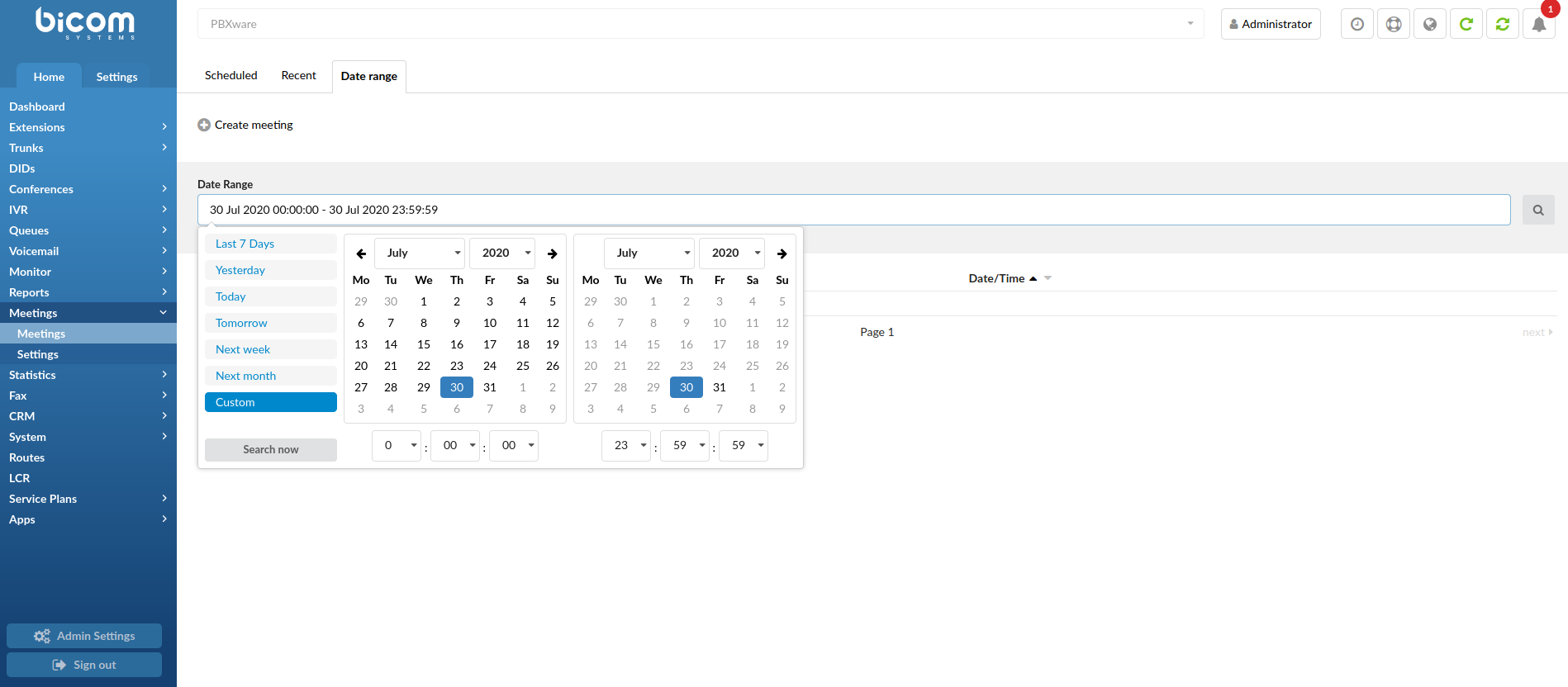
The list shows all meetings for the period selected, beginning from the start date and finishing with the end date.

Click this button to create a meeting.
(Button)
NOTE: For more information on creating meetings, please refer to the link.
- Date Range:
Select the start and end date by using search/filter.
(E.g. Click the 'Date Range' button and select the desired dates.)
(Option button)
After making any changes to the search filter, click the search icon.
NOTE: Lists can be sorted by Date/Time in the ascending or descending order.
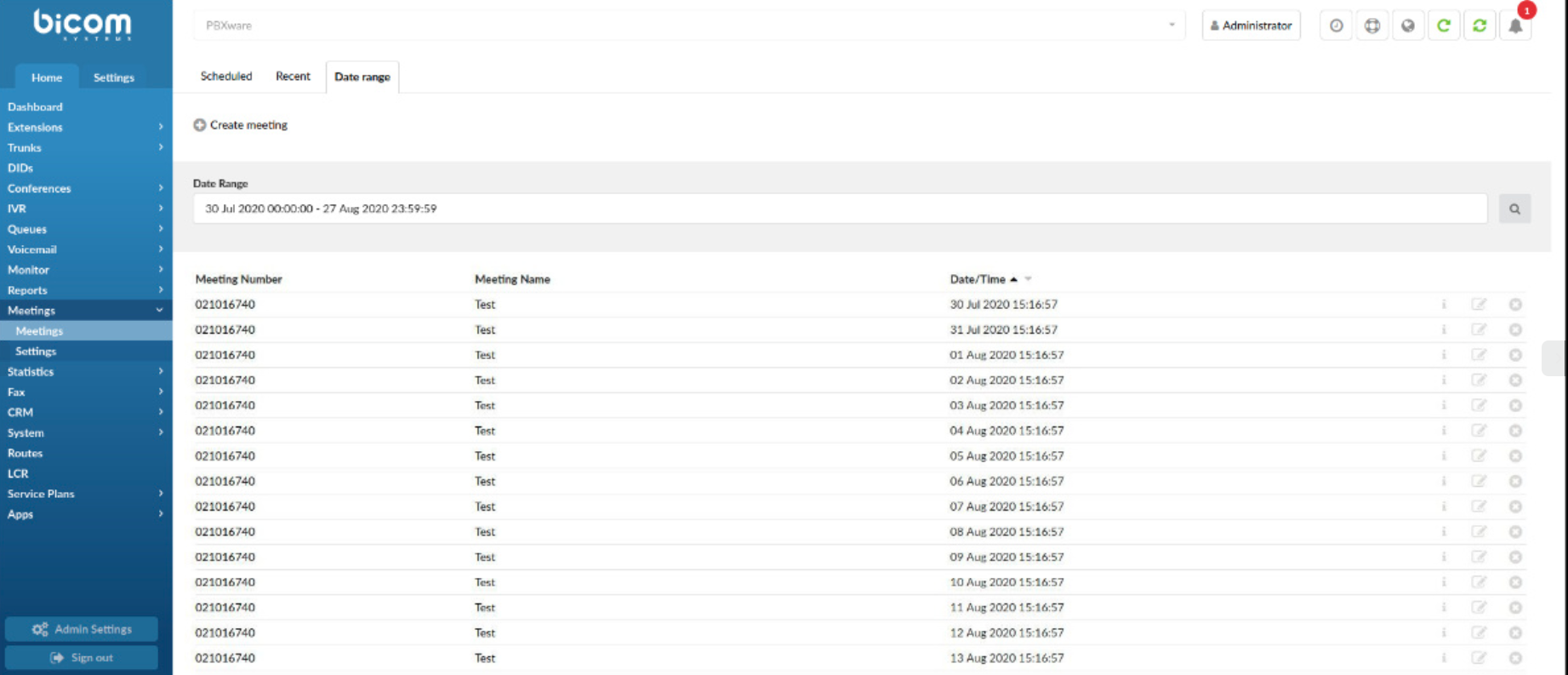
- Meeting Number:
Unique on the system with 9 digits.
NOTE: Hovering the mouse over the 9 digit meeting number and clicking it will prompt users to the Meeting Details page.
(E.g. 301027545)
(Display)
- Meeting Name:
Name of a selected Meeting.
NOTE: Hovering the mouse over the meeting name and clicking it will prompt users to the Meeting Details page.
(E.g. Daily Meeting)
(Display)
- Date/Time:
Meeting's date and time.
(28 Jul 2020 09:49:27)
(Display)
 Click this button to see the 'Meeting Details' page.
Click this button to see the 'Meeting Details' page.
NOTE: For more information on the page's content, please refer to the Meeting Details page.
(Button)
 Click this button to update the meeting.
Click this button to update the meeting.

NOTE: Upon clicking the button, the following warning message will appear: "Do you want to update all or just this instance of recurring meeting?". If 'Update this instance' is clicked, then any changes made to the meeting will be applied only to this recurring meeting. Otherwise, if users click the 'Update all instances' button, then changes will be applied to all meetings on the list.
For more information, please refer to the screenshot.
NOTE: Only meetings that have not been held yet can be updated on the 'Date Range' page.
(Button)
 Click this button to delete the meeting.
Click this button to delete the meeting.

NOTE: Upon deleting a single meeting, the warning message will appear saying "Are you sure you want to delete this meeting?". However, if a user deletes a recurrent meeting, the following warning message will appear: "Do you want to delete all or just this instance of recurring meeting?". If 'Delete this instance' is clicked, then only this recurring meeting will be deleted. Otherwise, if users click the 'Delete all instances' button, then all meetings on the list will be removed.
For more information, please refer to the screenshots.

(Button)
¶ Meeting Details
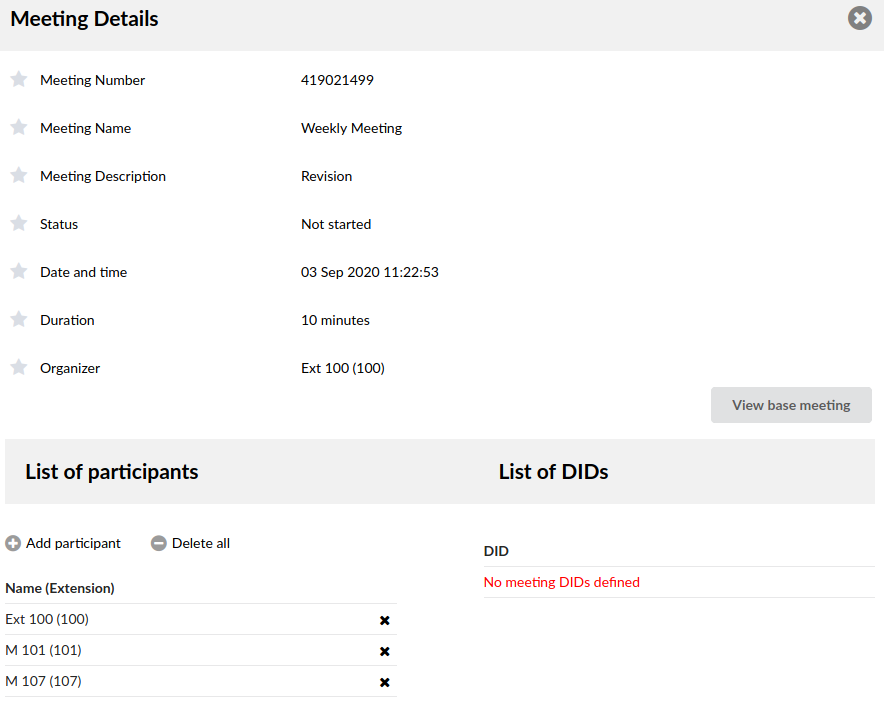
To open the 'Meeting Details' page, users can click 'Meeting Name', 'Meeting Number', or the 'Info' button. The 'Meeting Details' page contains the following information:
NOTE: If the meeting is recurrent, the 'View base meeting' button will be accessible. For more information on the 'View base meeting' button, please refer to the link.
- Meeting Number:
Unique on the system with 9 digits.
(E.g. 772023903)
(Display)
- Meeting Name:
Name given by the organizer when creating a Meeting.
(E.g. Daily Meeting)
(Display)
- Meeting Description
Additional information regarding the meeting.
(E.g. Revision)
[(a-z)(0-9)]
- Status:
Shows the meeting's status.
Status can be one of the following:
- Not started: A meeting has not been started yet.
- In progress: A meeting has already been started.
- Ended: A meeting has been held.
(Display)
- Date/Time:
Date and time showing if the meeting will take place or it has been held.
(30 Jul 2020 11:01:00)
(Display)
- Duration:
Time duration of a meeting.
(E.g. 10 minutes)
(Display)
- Organizer:
Name of the meeting's organizer and his/her Extension number.
(E.g. Ext 100 (100))
(Display)
The 'Meeting Details' page allows users to see the list of meeting's participants as well as the list of DIDs.

- List of Participants:
Shows Name and Extension of every participant in a meeting.
NOTE: For recent meetings, it is possible to see participants' Join and leave time. Please refer to the screenshot.

(E.g. Ext 100 (100))
(Display)
- List of DIDs:
Shows the list of DIDs found in the meeting.
(E.g. No meeting DIDs defined)
(Display)
 Click to add participants to the meeting.
Click to add participants to the meeting.
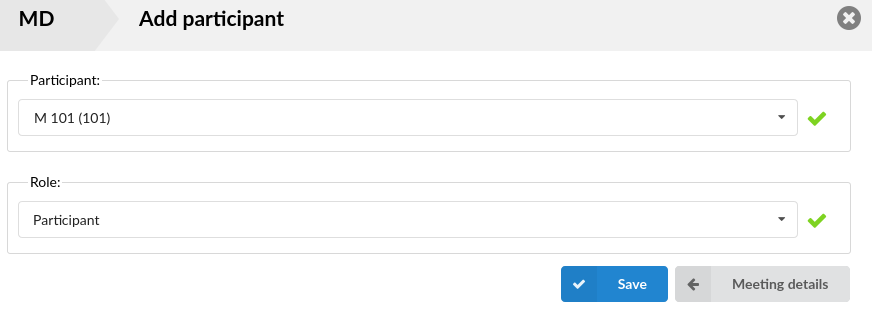

(E.g. Once clicked, the page for adding participants is opened. Please note that the same participant cannot be added twice. If added, the warning message will pop up saying "The participant is already added." Please refer to the screenshots.)
NOTE: The button is visible only if a user is an organizer, and if the Meeting has not been already held.
(Button)
- Participant
Select a participant and add him/her to the list.
(E.g. M 101 (101))
(Select box)
- Role
Assign a role to the selected Extension/participant.
(E.g. Participant/Administrator)
(Select box)
- Click to delete participants from the meeting.

(Once clicked, all participants except the organizer will be deleted. Since this is a deletion action, the warning message will pop up saying "Are you sure you want to delete all participants?". After confirmation, the message saying "Participants deleted successfully" should appear. Otherwise, if an error occurred, the message saying "Participant/s could not be deleted" should appear. For more information, please refer to the screenshots.)


NOTE: The button is visible only if a user is an organizer, and if the Meeting has not been already held. Also, please note that for any changes to be visible, users have to save the settings and open the 'Meeting Details' page again.
(Button)
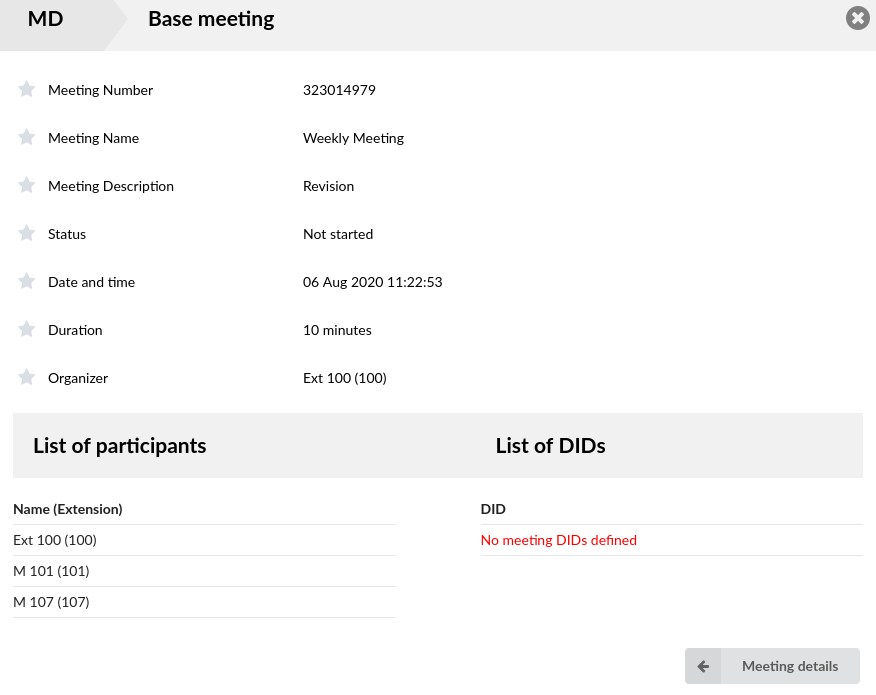
¶ View Base Meeting
 Click to 'View base meeting' details.
Click to 'View base meeting' details.
(E.g. Once clicked, users will be prompted to a different page. This page shares the same information found on the 'Meeting Details' page, however, from here, a user cannot manage participants.)
NOTE: The 'View base meeting' button is visible only if a Meeting is recurrent.
(Button)
 Click the button to return to the 'Meeting Details' page.
Click the button to return to the 'Meeting Details' page.
(Button)
.
¶ Licensing (6.7)
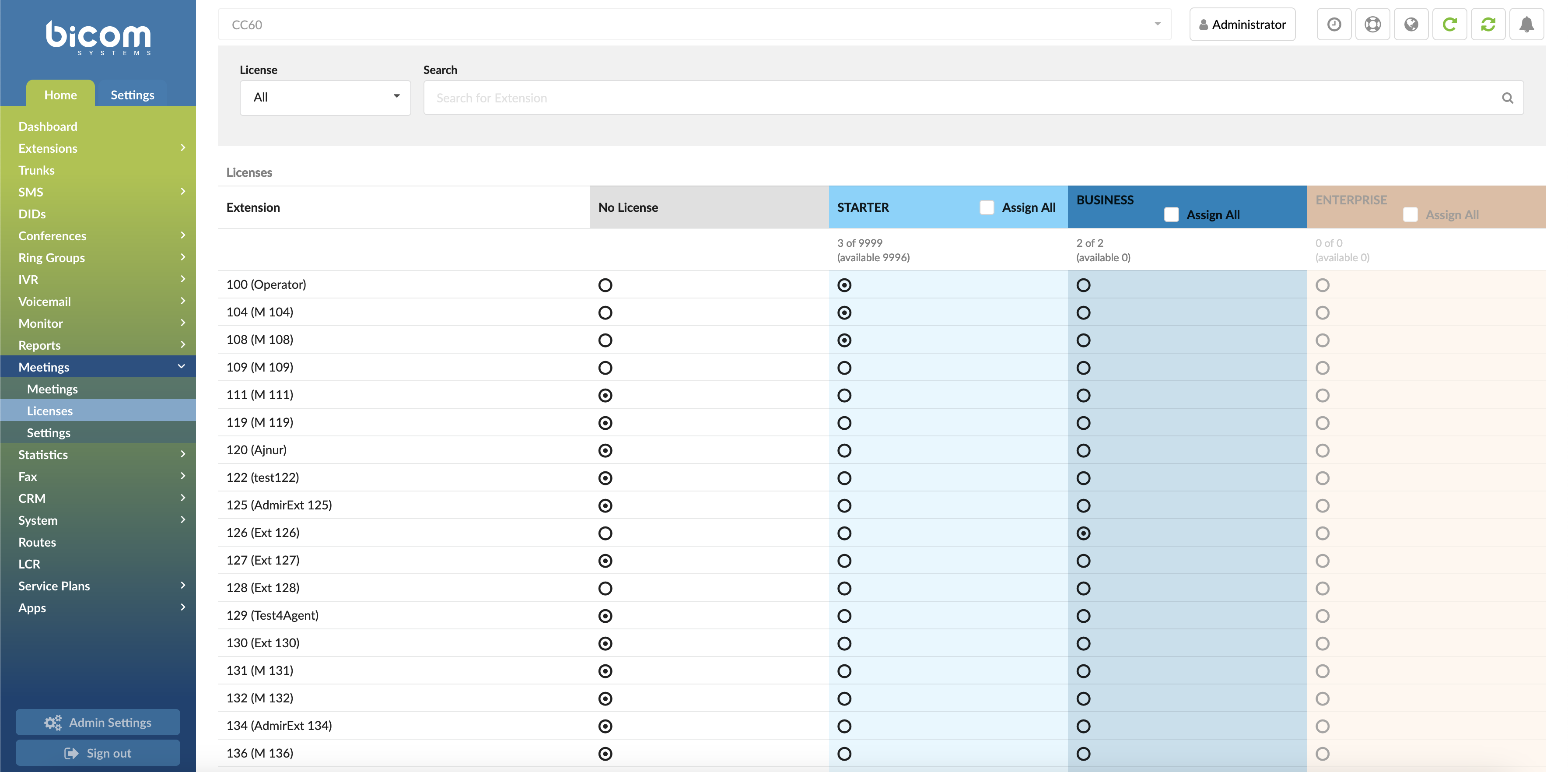
In PBXware 6.7 we are introducing a new page in the Meeting section, named Licensing. Licensing page enables PBXware administrator to easily assign Meeting edition permissions to one or more extensions on a system, from a central point. This feature should severely speed up the workflow of assigning a large volume of meeting licenses.
On top of the page status bar provides information about the edition and current status of assigned meeting licenses.
Assigning licenses is straightforward, and all you need to do to assign a specific edition license to an extension is to click on a corresponding edition button, associated with the extension number you would like to assign this edition to.

In addition to manually assigning a preferred edition to one or more extensions, the administrator also has the option to select the "Assign All" checkbox, located next to the edition name, in order to assign a specific edition to all extensions on a tenant.
When you select the checkbox to use the "Assign All" option you will be presented with a confirmation dialog, and you will need to click OK to confirm the change.

.
¶ Meeting Licensing Changes (v6.7)
With the update of our products to v6.7, there will be a new version of BRM for Meeting pricing, affecting all Meeting users regardless of the software version they are on.
All current Meeting users will be automatically assigned Starter packages for all the extensions in the tenant with a Meeting license.
This includes the following gloCOM editions: Business, CC and Supervisor. Office edition doesn’t have Meeting licenses.
So, all current Meeting users (regardless if they’ve upgraded to v6.7, or stayed on v6.6 and lower) will still have Meeting, it will be free, but at a limited capacity (Starter limitation).
In order to buy a Business package, users will have to upgrade to v6.7 of PBXware.
The limitations of the Meeting packages are as follows:
| Licenses | Starter (free) | Business |
|---|---|---|
| Max no. of participants | 10 | 100 |
| Max duration of the meeting | 45 min | 240 min |
| Max. no. of concurrent meetings per tenant | 1 for all starter licenses | X = no. of licenses |
.
¶ Settings
¶ Daily digest
Daily digest is used for setting a reminder about receiving any daily e-mails for meetings.
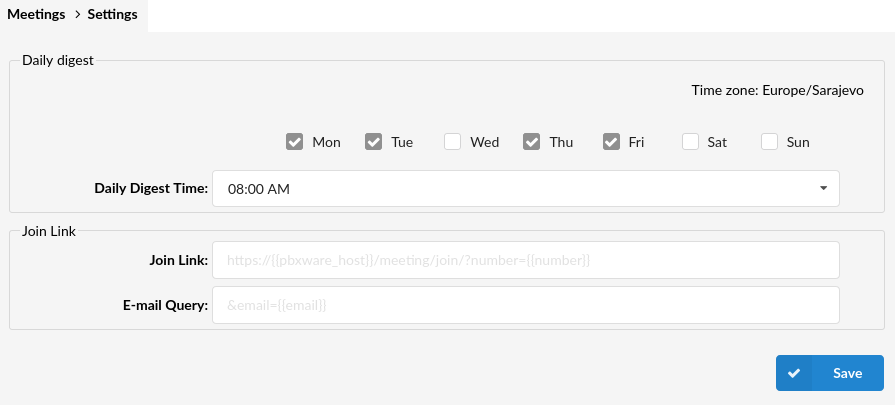
- Time Zone:
Displays chosen time zone
(E.g. Europe/London)
(Display)
- Week Days:
Specifies days in a week when e-mails will be sent.
(E.g. Mon, Tue, Wed, Thu, Fri)
(Checkbox)
- Daily Digest Time:
Select time for receiving daily e-mails.
(E.g. 08:00 AM)
(Select box)
NOTE: Time for receiving meetings' daily e-mails is saved in UTC (Universal Time Coordinated). The administrator will see the time set according to his/her time zone. It can be set per Extension.
¶ Join Link
The ‘Join Link’ section enables users to customize join links for meetings which are used for inviting attendees to meetings. Attendees can join public or regular meetings as long as they have the join link.
Participants can join a meeting in two ways:
- By copying the link from gloCOM
- By clicking the ‘Join meeting’ button found in the meeting invitation e-mail.
The default link template for public meetings is as follows:

The default link template for regular meetings is as follows:

Example (as shown in a browser):
If the information is as follows:
- The host is “pbx.bicomsystems.com”,
- The meeting number is “1234567”,
- The email is “test@test.com”,
Then, the generated link is:
https://pbx.bicomsystems.com/meeting/join/?number=1234567&email=test@test.com
The ‘Join Link’ section has the ‘Join Link’ and ‘E-mail Query’ fields. Users may choose to customize join links by filling one of the fields (or both) in the PBXware GUI.
NOTE: The customized join links are set per Tenant.
Customization
PBXware users may leave the ‘Join Link’ and ‘E-mail Query’ fields empty, and in that case, the default values will be used. Otherwise, if the fields are populated, the customized link will be used.
Regular Meetings
For regular meetings, both the ‘Join LInk’ and ‘E-mail Query’ fields have to be populated. By having the ‘E-mail Query’ field populated, the admin of the system, a Tenant, or a user who has privileges to see the Meetings Settings page may customize the link for specific attendees to join the meeting by using the link.
Public Meetings
For public meetings, the ‘E-mail Query’ field will not be used to produce the join link since one link is shared to a number of participants. (Desktop/web applications only get a meeting number and fill e-mail credentials from the previously saved data or ask the user to enter his/her personal details, such as an e-mail address and a name).
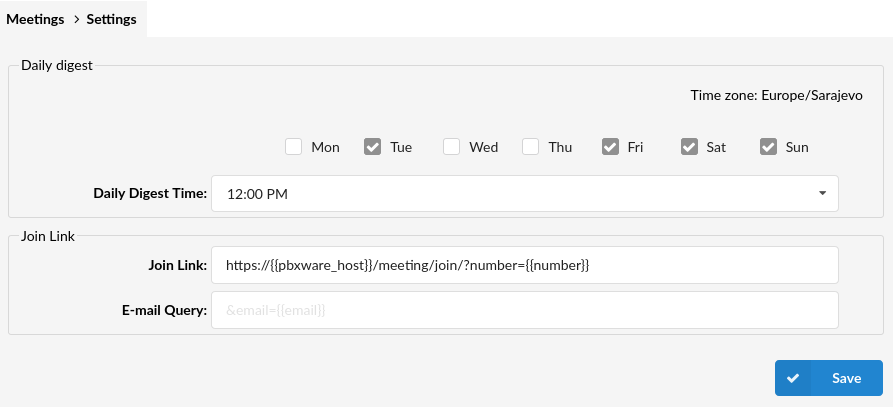
¶ Parameters
- https
Stands for the URL protocol. The ‘https’ protocol will bring users to a browser window before joining the meeting and ensure that all communications between the users' browser and the website are encrypted.
 Stands for the domain name. This is an optional placeholder, and if present, it is substituted by the PBXware domain name.
Stands for the domain name. This is an optional placeholder, and if present, it is substituted by the PBXware domain name.
NOTE: A user may enter a different domain name in case s(he) does not use the PBXware domain name.
(E.g. pbx.bicomsystems.com)
([a-z][0-9])
 Stands for the meeting number. This is a required placeholder, and it gets substituted with a meeting number when creating a meeting join link.
Stands for the meeting number. This is a required placeholder, and it gets substituted with a meeting number when creating a meeting join link.
(E.g. number=1234567)
([0-9])

NOTE: In order for a join link to be complete, a number of the meeting has to be added to the path. In case there is no meeting number, a warning message will appear saying that the number is missing in the Join Link field. Please read the documentation. For more information, please refer to the screenshot below.
 Stands for the e-mail address of the attendee. This is a required placeholder and it gets substituted by e-mail when creating a meeting join link for e-mail invitations (in PBXware).
Stands for the e-mail address of the attendee. This is a required placeholder and it gets substituted by e-mail when creating a meeting join link for e-mail invitations (in PBXware).
(E.g. email=test@test.com)
([a-z][0-9])
¶ Landing Page
The default landing page shipped with PBXware is as follows:
/opt/pbxware/pw/home/sitemanager/admin/meeting/join/index.html
This page uses ifreame to embed the original Join Meeting page.
<html lang="en" class="no-js">
<head>
<meta charset="utf-8">
<meta name="viewport" content="width=device-width,initial-scale=1.0">
<style>
html body {width: 100%;height: 100%;padding: 0px;margin: 0px;overflow: hidden;font-family: arial;font-size: 10px;color: #6e6e6e;background-color: #000;} #preview-frame {width: 100%;background-color: #fff;}</style>
<script src="//ajax.googleapis.com/ajax/libs/jquery/1.10.2/jquery.min.js"></script>
<script>
var calcHeight = function() {
$('#preview-frame').height($(window).height());
}
$(document).ready(function() {
calcHeight();
});
$(window).resize(function() {
calcHeight();
}).load(function() {
calcHeight();
});
$( document ).ready(function() {
uri = "
https://meeting.bicomsystems.com/join
" + document.location.search;
$('#preview-frame').attr('src', uri);
});
</script>
</head>
<body>
<iframe id="preview-frame" src="
https://meeting.bicomsystems.com/join
" name="preview-frame" frameborder="0" noresize="noresize" style="height: 100%;">
</iframe>
</body>
</html>